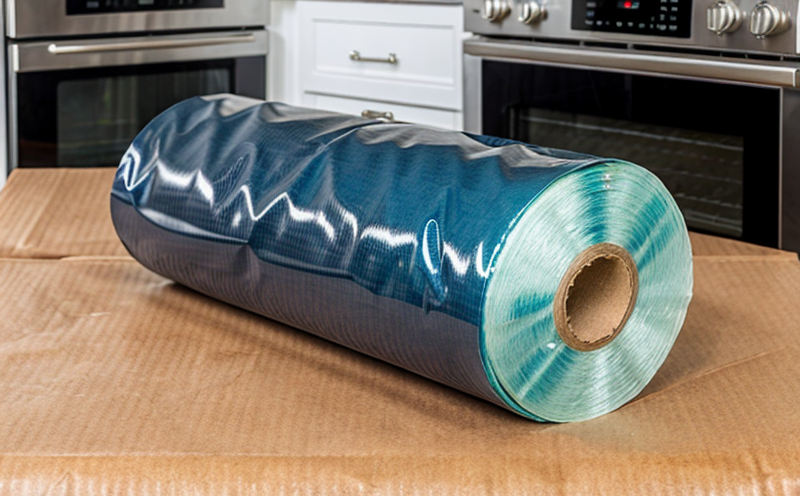BS EN 15187 Colour Fastness Testing of Printed Plastic Wraps
In the realm of household wraps and covers plastics testing, ensuring that printed plastic wraps remain colourfast under various environmental conditions is critical for product longevity and customer satisfaction. BS EN 15187 specifies a method for determining the resistance of printed plastic films to rubbing with water, which is essential for products like garbage bags, bin liners, and other household wrap applications.
The test aims to evaluate how well the ink or print adheres to the surface of the plastic. This is important because if the colour does not remain fast, it can lead to unwanted transfer onto other surfaces during use. The standard covers a range of conditions that mimic real-world scenarios such as exposure to moisture and rubbing.
The testing process involves preparing specimens according to specified dimensions and printing requirements. The printed side is then exposed to a rubbing action using a standardized piece of cloth with water, simulating the kind of friction and contact the product might encounter during use. After a predetermined number of rubbing cycles, the colour fastness is assessed visually or spectrophotometrically.
Understanding the parameters involved in this test helps quality managers, compliance officers, R&D engineers, and procurement specialists to ensure that their products meet international standards and consumer expectations. This testing method plays a crucial role in the development of household wraps and covers, ensuring they remain attractive and functional throughout their lifecycle.
For instance, if a new bin liner is expected to be exposed to frequent rubbing during use, it's vital for manufacturers to subject this product to BS EN 15187 testing. This ensures that the printed graphics will not only adhere well but also remain vibrant and legible over time.
- The test helps in identifying potential issues with ink adhesion early in the development process, allowing for necessary adjustments before mass production.
- It ensures that products meet consumer expectations regarding appearance and longevity.
- The results of this testing can influence marketing strategies by highlighting product durability and aesthetic appeal.
In summary, BS EN 15187 is a vital tool in the quality assurance process for household wraps and covers. It ensures that products not only meet regulatory requirements but also exceed customer expectations in terms of appearance and performance.
Eurolab Advantages
EuroLab stands out as a premier provider of BS EN 15187 colour fastness testing for printed plastic wraps. With our state-of-the-art facilities, we offer unparalleled precision and reliability in our testing processes.
- Our experienced technicians are trained to conduct tests according to the latest international standards, ensuring accurate results every time.
- We utilize cutting-edge equipment that guarantees consistent performance and accuracy across all tests.
- EuroLab’s comprehensive approach ensures that our clients receive not just test results but also actionable insights into their product performance.
Our commitment to quality is reflected in the numerous certifications we hold, including ISO 9001 for Quality Management. We pride ourselves on delivering services that are both compliant and innovative, meeting the needs of our diverse client base.
With a reputation built on trust and excellence, EuroLab remains at the forefront of polymer & plastics testing, offering the expertise needed to navigate the complexities of international standards and customer expectations.
International Acceptance and Recognition
The BS EN 15187 standard has gained significant recognition in the field of household wraps and covers plastics testing. Its acceptance by major global brands ensures that products meeting these standards are trusted worldwide.
This international standard is widely used across Europe, Asia, and North America, with numerous manufacturers adopting it as a benchmark for quality. The widespread acceptance of this standard reflects its importance in ensuring product reliability and customer satisfaction.
Companies that adhere to BS EN 15187 not only meet regulatory requirements but also gain a competitive edge by demonstrating their commitment to high-quality standards. This can lead to increased market share, enhanced brand reputation, and better customer trust.
Competitive Advantage and Market Impact
- Enhanced Product Reliability: By adhering to BS EN 15187 standards, manufacturers can ensure that their products are robust and reliable, which is crucial for household wraps.
- Innovation Leadership: Compliance with international standards allows companies to innovate while maintaining a high level of quality assurance. This can lead to the development of new and improved products.
- Market Access: Meeting these standards opens doors to global markets, providing manufacturers with greater opportunities for expansion.
The market impact of BS EN 15187 is profound. Consumers are increasingly demanding higher quality and durability from household products, and companies that meet these standards can better satisfy this demand. This not only enhances brand reputation but also fosters customer loyalty and trust.





